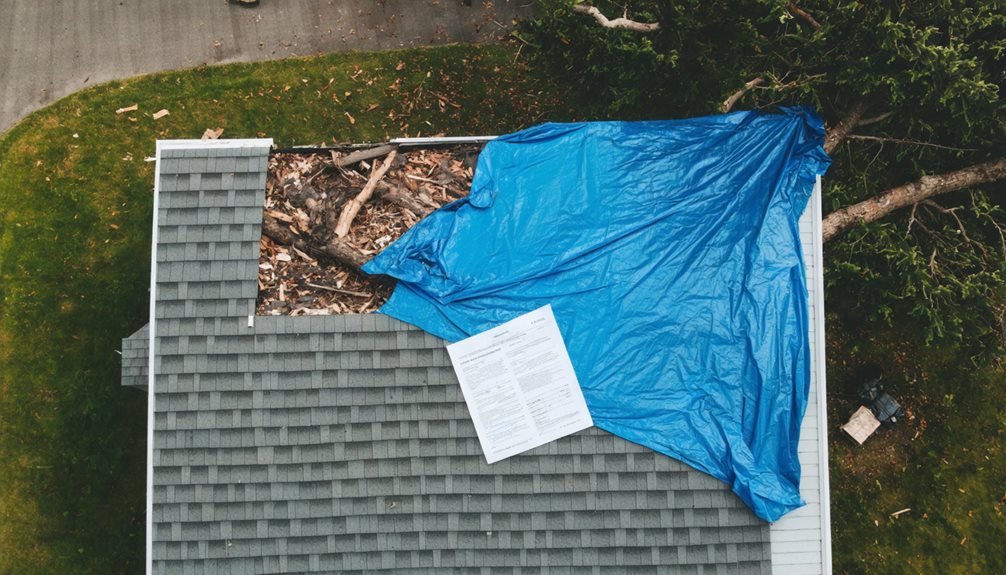Thoroughly document all damage with date-stamped photos and video before making emergency repairs. Secure your property with tarps and bracing to prevent further damage, keeping receipts for all materials. Review your policy to understand wind damage coverage, deductibles, and exclusion clauses. Create a detailed inventory of damaged items with approximate values. Verify contractor credentials, especially for wind damage restoration expertise. These essential steps will significantly strengthen your position when filing your claim.
Table of Contents
ToggleKey Takeaways
- Document all damage with detailed photos and videos, including wide-angle shots for context and close-ups of specific issues.
- Review your insurance policy for wind damage coverage limits, exclusions, and deductibles before filing a claim.
- Implement temporary repairs like tarping and bracing to prevent further damage, keeping receipts for insurance reimbursement.
- Verify contractor credentials specifically related to wind damage restoration and examine their previous storm project work.
- Maintain a comprehensive inventory of damaged items with descriptions, estimated values, and model/serial numbers where applicable.
Document All Damage With Photos and Video Evidence
Comprehensive documentation serves as the foundation of a successful wind damage restoration claim. Before initiating repairs, capture clear, high-resolution images and video footage of all affected areas. Document exterior damage to roofing, siding, windows, and landscaping, as well as any interior water infiltration or structural issues resulting from wind exposure.
Implement systematic photo organization by creating separate digital folders for different damage categories. Label each file with the date and specific location to establish a chronological record. Evidence preservation requires immediate action—capture the damage before emergency repairs alter the scene. Include wide-angle shots for context and close-ups of specific damage points.
For maximum claim effectiveness, photograph serial numbers of damaged appliances and include a measuring tool in images to demonstrate size and scale of structural damage.
Secure Your Property to Prevent Additional Damage
After identifying wind damage, you’ll need to promptly secure your property to prevent further deterioration. Tarping damaged roof areas and bracing weakened structural components are critical temporary measures that protect your home’s interior from water intrusion and structural collapse. Before implementing these protective measures, document the existing conditions with photographs to support insurance claims and provide baseline evidence of damage prior to your mitigation efforts.
Tarping Damaged Roof Areas
Temporary roof tarping serves as a critical first response to wind damage, preventing water infiltration and subsequent structural deterioration. You’ll need to assess the damaged area before selecting appropriate tarp sizes for complete coverage, extending at least 4 feet beyond compromised sections.
| Installation Step | Equipment Required | Technical Considerations |
|---|---|---|
| Secure perimeter | Lumber (2×4) | Place boards at 8-10″ intervals |
| Attachment method | Deck screws, nails | Avoid puncturing undamaged shingles |
| Tarp positioning | Heavy-duty tarps | Overlap sections by minimum 12″ |
| Weighting system | Sandbags, bricks | Place at 24″ intervals along edges |
| Edge securement | Furring strips | Wrap tarp edges around boards |
Proper installation techniques include working from bottom to top and creating drainage pathways to prevent water pooling. Use cap nails rather than standard roofing nails for stronger temporary anchoring without causing additional damage to salvageable roofing materials.
Bracing Weak Structures
When wind damage compromises structural elements of your property, immediate bracing becomes essential to prevent progressive failure and secondary damage during recovery efforts. Identify weakened wall sections, sagging beams, and compromised roof trusses that may collapse under additional wind load.
Install temporary structural reinforcement using 2×4 lumber in triangular configurations against damaged walls. Place diagonal braces at 45-degree angles, securing them to both floor and intact wall studs. For damaged roof structures, position vertical shores under compromised rafters, distributing the load to stable floor areas below.
Document all temporary bracing with photographs before your insurance adjuster arrives. This evidence demonstrates your proactive approach to mitigating further damage. Keep in mind that properly executed bracing not only protects your property but also creates a safer environment for assessment teams and restoration workers.
Document Existing Conditions
Thorough documentation of existing damage serves as critical evidence for insurance claims and provides baseline measurements for restoration planning. Before touching anything, capture comprehensive photographic and video evidence of all wind-damaged areas from multiple angles and distances.
Create a detailed property assessment log noting the date and time of damage, weather conditions, and specific descriptions of each affected component. Measure and record dimensions of damaged sections, including depth of water intrusion if applicable. Don’t overlook less obvious areas like crawlspaces, utility connections, and roof underlayment.
Document the existing conditions of personal belongings, noting model numbers and approximate values of damaged items. This systematic approach guarantees you’ve established an indisputable record of pre-restoration conditions that will prove invaluable when negotiating with insurance adjusters.
Review Your Insurance Policy Coverage for Wind Events
Understanding your insurance policy‘s specific coverage for wind damage is vital before disaster strikes. Review your policy documents to determine the extent of wind event coverage and identify any policy exclusions that could affect your claim. Most standard policies cover wind damage, but coverage limits and deductibles vary significantly.
- Check for named storm deductibles, which typically require higher out-of-pocket costs for hurricane or tropical storm damage
- Identify coverage for secondary damage such as water intrusion resulting from compromised roofing or structures
- Verify if additional living expenses are covered should your home become uninhabitable
- Determine if outbuildings, fences, or landscaping have separate coverage limits or are excluded entirely
Contact your insurance agent with specific questions about coverage gaps to guarantee adequate protection before experiencing wind-related property damage.
Create a Detailed Inventory of Damaged Items
After experiencing wind damage, creating a comprehensive inventory of affected items constitutes a vital step in the restoration and claims process. Document each damaged possession with methodical precision, noting specific item descriptions, dimensions, materials, and distinguishing features. Photograph all items from multiple angles, ensuring visible damage is clearly captured alongside any identifying markers or serial numbers.
Organize your inventory systematically by room or category, assigning estimated values based on original purchase price, current replacement cost, and depreciation factors. Include acquisition dates and supporting documentation such as receipts, warranty information, or appraisals whenever possible. For high-value possessions, consider consulting specialized appraisers to establish accurate valuations.
This detailed catalog serves as vital evidence for your insurance claim, potentially expediting the assessment process and maximizing your settlement amount.
Research Local Restoration Companies With Wind Expertise
When selecting a restoration company for wind damage, you’ll need to verify their specialized wind damage certifications such as those from IICRC or RIA. Confirm their guaranteed emergency response times, as delays can exacerbate structural issues and lead to secondary water infiltration problems. Review their portfolio of previous storm restoration projects, focusing specifically on properties that experienced similar wind-related challenges to your situation.
Verify Specialized Wind Certifications
Before hiring a restoration company for wind damage repair, you’ll need to research contractors who possess legitimate wind-specific certifications and expertise. The wind certification importance cannot be overstated when selecting qualified professionals to restore your property. Verify contractor qualifications by examining their industry credentials and specialized training.
Look for these essential certifications:
- IICRC Wind Damage Restoration Technician (WDRT) certification
- Institute for Business & Home Safety (IBHS) Fortified program recognition
- Roofing Wind Certification from recognized industry associations
- FEMA Windstorm Mitigation Specialist designation
Request documentation of these credentials and verify their authenticity through the issuing organizations’ websites. Certified contractors understand wind-specific damage patterns, structural vulnerabilities, and proper remediation techniques. They’ll accurately assess damage that insurance adjusters might miss and implement repairs that strengthen your property against future wind events.
Emergency Response Time Guarantees
During a wind damage emergency, restoration companies’ response time directly impacts recovery outcomes and prevents secondary damage. Scrutinize potential contractors’ guaranteed arrival windows—industry leaders typically commit to 1-4 hour response times for wind damage scenarios.
Request documented evidence of their emergency planning protocols and historical response metrics before signing service agreements. Companies with established response strategies typically maintain dedicated dispatch systems, pre-positioned equipment, and 24/7 staffing models.
Verify whether their guarantees include penalties for delayed arrivals or merely represent aspirational targets. The most reputable firms offer financial compensation when response times exceed promised windows. Additionally, examine how weather conditions, multiple disaster events, or seasonal factors might modify their standard response guarantees—essential considerations during peak storm seasons when service demands surge beyond capacity.
Check Previous Storm Projects
Evaluating restoration contractors’ previous wind damage projects provides essential insights into their practical expertise and service quality. When researching companies with wind damage expertise, conduct thorough project analysis of their storm history to confirm their capabilities match your specific situation.
- Request detailed case studies showing before/after documentation and specific wind damage solutions implemented
- Verify completion timelines for similar projects to ascertain the contractor can deliver results efficiently
- Examine customer testimonials specifically related to wind restoration claims and insurance coordination
- Assess their portfolio for projects in your area, as local storm pattern knowledge significantly impacts restoration quality
This investigation reveals contractors’ actual performance rather than marketing claims. Companies with transparent project histories typically demonstrate greater accountability and technical proficiency in handling complex wind damage situations.

Understand What Emergency Repairs You Can Make Now
While professional restoration services are essential for comprehensive wind damage repairs, certain emergency interventions fall within a homeowner’s capability. You’ll need to distinguish between temporary measures you can implement immediately and those requiring professional expertise.
| Emergency Action | Required Tools | Safety Considerations |
|---|---|---|
| Tarp roof breaches | Heavy-duty tarp, nails, lumber | Use proper ladder protocol |
| Clear debris | Work gloves, goggles, chainsaw | Avoid downed power lines |
| Dry wet areas | Fans, dehumidifiers, towels | Disconnect electrical sources |
Before initiating any repairs, maintain a comprehensive list of emergency contacts including your insurance provider, licensed contractors, and restoration specialists. Assemble essential repair tools in advance: hammers, heavy-duty tarps, cordless drill, and moisture meters. Document all emergency repairs with photographs and receipts, as these temporary interventions demonstrate your commitment to mitigating further damage—a factor insurance companies evaluate during claims assessment.
Gather Essential Records and Documentation of Property Value
Proper documentation of wind damage requires comprehensive photographic evidence of all affected areas to establish the extent of destruction. You’ll need to create a detailed inventory of pre-disaster valuables, including purchase dates and estimated values, to substantiate insurance claims effectively. Keep meticulous records of all repair expenses, including receipts, contractor estimates, and payment confirmations, as these will prove essential for insurance reimbursement and potential tax deduction purposes.
Photograph All Damage
One essential step after experiencing wind damage is to thoroughly document all affected areas of your property with photographs. Comprehensive visual documentation serves as critical evidence for your insurance claim and establishes a baseline for damage assessment. Implement these systematic photograph techniques to guarantee complete coverage:
- Capture wide-angle shots first to establish context, then close-ups of specific damage points
- Document all affected areas including roof, siding, windows, landscaping, and personal property
- Use consistent lighting conditions and include a ruler or common object for scale reference
- Create a chronological series of images showing damage progression if safe to do so
This methodical approach provides insurers with clear evidence of wind-related damages and strengthens your position during claim negotiations.
Inventory Pre-Disaster Valuables
Comprehensive documentation of your valuables should ideally occur before wind damage strikes your property. Establish a systematic valuables organization protocol that includes digital photographs, purchase receipts, and detailed descriptions of significant items. Document model numbers, serial numbers, and acquisition dates for electronics, appliances, and machinery.
As part of your disaster preparedness strategy, maintain a secure digital inventory in cloud storage and physical copies in waterproof containers stored off-site. Include professional appraisals for high-value items such as artwork, jewelry, and antiques. Update this inventory annually or whenever significant purchases occur.
This meticulous documentation establishes baseline property conditions and values, significantly expediting insurance claims following wind damage events. Insurance adjusters will require verification of pre-disaster property condition to process your claim efficiently.
Document Repair Expenses
Once wind damage has occurred, meticulous documentation of all repair expenses becomes your next vital task after inventory assessment. Establishing repair budgets and tracking all expenditures provides essential evidence for insurance claims and potential tax deductions for uninsured losses.
Maintain comprehensive records through these important practices:
- Create digital folders for all repair invoices, cost estimates, and contractor communications
- Photograph or scan receipts immediately upon receipt to prevent loss from damage or fading
- Track labor costs separately from materials, noting hourly rates and time spent
- Maintain a spreadsheet categorizing expenses by room or damage type to identify cost patterns
This systematic approach guarantees maximum reimbursement while preventing disputes with insurers about the legitimacy of claimed expenses. Effective documentation also helps you manage repair budgets through the restoration process.
Safety Precautions When Assessing Wind Damage
Before entering any storm-damaged property, you’ll need to implement strict safety protocols to prevent injury or further complications. Prioritize your well-being by wearing appropriate safety gear including hard hats, heavy-duty gloves, and steel-toed boots. Carry an emergency kit containing first aid supplies, flashlights, and a multi-tool.
| Hazard Type | Warning Signs | Precautionary Measures |
|---|---|---|
| Structural | Leaning walls, sagging roofs | Avoid entry until professional assessment |
| Electrical | Exposed wiring, standing water | Cut power at main breaker, use insulated tools |
| Biological | Mold growth, contaminated water | Wear respirators, waterproof clothing |
Document all damage from a safe distance if possible. Never enter buildings with significant structural compromise. Wait for daylight to conduct assessments to maximize visibility and reduce accident risk. Prioritize safety over expediting insurance documentation.
Temporary Housing Options During Major Restorations
When severe wind damage necessitates extensive home repairs, you’ll need to secure temporary accommodations that balance comfort, cost, and convenience. Your insurance policy’s Additional Living Expense (ALE) coverage typically funds these emergency housing solutions while contractors restore your property to habitable condition.
Consider these temporary accommodation options:
- Short-term rentals (Airbnb, VRBO) – Provide immediate flexibility with varying amenities and locations relative to your damaged property
- Extended-stay hotels – Offer kitchen facilities and reduced weekly/monthly rates with simplified billing documentation for insurance claims
- Corporate housing – Features fully-furnished units with utilities included, ideal for restorations exceeding 30 days
- Friends/family residences – Presents the most economical solution, though document any expenses incurred for potential reimbursement
Contact your insurer immediately to verify coverage limits and required documentation before finalizing any temporary housing arrangements.
Working With Public Adjusters vs. Company Adjusters
After securing your temporary housing, the next phase of wind damage restoration involves managing the claims adjustment process. Understanding the difference between public and company adjusters is essential for maximizing your settlement.
| Factor | Company Adjuster | Public Adjuster |
|---|---|---|
| Loyalty | Insurance company | Policyholder |
| Cost | Free (paid by insurer) | 5-15% of settlement |
| Expertise | General claims knowledge | Specialized in maximizing claims |
| Availability | Limited by caseload | More dedicated attention |
| Negotiation | Works within company parameters | Advocates specifically for you |
Company adjuster limitations include potential conflicts of interest and volume-based case management that may overlook claim details. Public adjuster benefits include specialized knowledge of policy language, documentation requirements, and negotiation advantages that often results in settlements 30-40% higher than unrepresented claims. Consider hiring a public adjuster for complex cases exceeding $10,000 in damages.
Frequently Asked Questions
How Long Do I Have to File a Wind Damage Insurance Claim?
You typically have 1-5 years to file a wind damage insurance claim, with 60% of insurers preferring notification within 30-60 days. Check your policy’s specific claim deadlines, as they vary significantly between providers. Follow filing procedures meticulously by documenting damage with photos, gathering repair estimates, and submitting your claim form promptly. Your insurer may deny coverage if you exceed the statutory limitation period, which differs by state jurisdiction and policy terms.
Will My Insurance Rates Increase After Filing a Wind Damage Claim?
Filing a wind damage claim may increase your insurance premiums, though it’s not guaranteed. Insurers evaluate claim frequency impact when determining rate adjustments. A single claim typically has minimal effect, but multiple claims within 3-5 years significantly enhance your risk profile. Premium increases vary by carrier, location, and claim amount. Some companies offer claim forgiveness programs that protect policyholders from rate hikes following first-time or weather-related claims.
Can I Choose My Own Contractors for Wind Damage Repairs?
Yes, you can typically choose your own contractors for wind damage repairs. Your insurance policy likely confirms your right to contractor selection, though some insurers maintain preferred vendor lists. During the repair process, document your chosen contractor’s credentials, licensing, and insurance to satisfy your insurer’s requirements. Inform your insurance company about your selection before work begins to guarantee compliance with policy terms and facilitate smoother claim processing.
Are Fallen Trees From Wind Covered by Standard Homeowners Insurance?
Yes, standard homeowners insurance typically covers fallen trees caused by wind. Your policy coverage generally includes both tree removal and the damage caused to insured structures. However, specifics vary by insurer; you’ll need to review your particular policy for coverage limits and deductibles. If the tree falls without damaging insured property, you might receive limited or no coverage for removal costs. Document the damage thoroughly before arranging removal to support your claim.
What Wind Speed Qualifies as Storm Damage for Insurance Purposes?
Ever wondered what makes wind “damaging” to insurers? There’s no universal wind speed threshold that automatically qualifies as storm damage. Your insurance policy terms typically define this specifically. Most policies consider winds exceeding 50-60 mph as potentially damaging, but documentation matters more than the exact speed. You’ll need to demonstrate that wind actually caused your damage. Always review your specific policy language, as wind speed thresholds vary significantly between insurers and regions.


